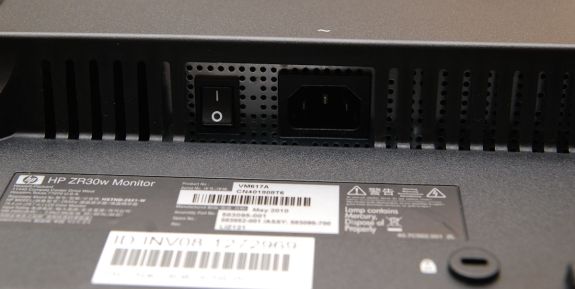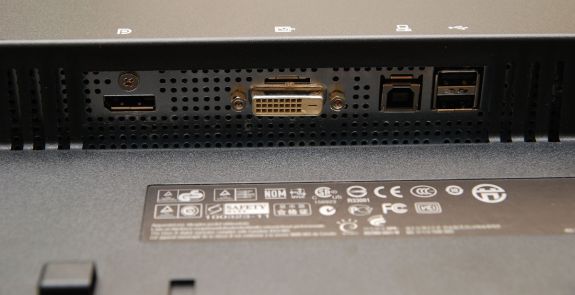A New 30" Contender: HP ZR30w Review
by Brian Klug on June 1, 2010 6:30 PM ESTThe LCD market continues to be one of the frequently updated segments in the consumer electronics segment, as OEMs and vendors alike are eager to bundle their high-end, high performance displays with professional workstations. The ZR30w belongs to that same pro market, offering a 10-bit panel with 1.07 billion colors - for an advertised 99 percent coverage of the AdobeRGB 1998 gamut and 30-bit per pixel color. HP claims that the ZR30w is the first 30" display to break 1 billion colors. When you’re selling a 30” LCD to enthusiasts, every bit of performance matters, and as we’ll show in a bit, the ZR30w doesn’t fail to impress.
As already noted, the ZR30w is targeted primarily at enthusiasts and professionals who demand accurate color tracking and equally large gamut. As with all 30” displays, every detail counts, as this segment represents generally the best of the best for manufacturers. It makes sense, too, since enthusiasts and professionals alike who are serious about getting the absolute largest in display real-estate also care about color tracking and gamut. They expect top performance, and are willing to pay for it. Though similar real-estate can almost be captured with arrays of smaller panels, for most, the 30” segment remains the most lust-worthy among displays thanks to the truly uninterrupted space.
The last 30” HP LCD we touched was the venerable HP LP3065 back in 2007. The LP3065 is still available today as well at $1,349 on HP’s website. The ZR30w is being introduced at a price point of $1,299 - some $300 below Dell’s UltraSharp 3008WFP display. Interestingly enough, the ZR30w does away with the plethora of DVI-D ports we praised the LP3065 for having (almost doubling as a KVM switch). It trims down the 3 DVI-D ports in the LP3065 to 1 DVI-D port and a DisplayPort for the ZR30w. That’s not a deal breaker, but you’re still one input shorter a generation later, which is a bit puzzling. Considering other 30” displays include a plethora of input options, we find the ZR30’s a bit spartan - an HDMI port or component would be welcome additions.
Before we go any further though, let’s dive into the specifications:
| HP ZR30w - Specifications | |||
| Property | Quoted Specification | ||
| Video Inputs | DVI-D, DisplayPort (both with HDCP) | ||
| Panel Type | S-IPS/H2-IPS (CN401808T6 unknown manufacturer) | ||
| Pixel Pitch | 0.250 mm | ||
| Colors | 1.07 billion colors (30 bits) | ||
| Brightness | 370 nits typical | ||
| Contrast Ratio | 1000:1 normal, 3000:1 (dynamic) | ||
| Response Time | 7ms (g2g), 12ms (on to off) | ||
| Viewable Size | 29.7" Diagonal | ||
| Resolution | 2560x1600 (WQXGA) | ||
| Viewing Angle | 178 degrees horizontal and vertical | ||
| Power Consumption (operation) | <130 watts typical, <185 watts maximum | ||
| Power Consumption (standby) | <2 watts sleep | ||
| Screen Treatment | Matte (anti-glare) | ||
| Height-Adjustable | Yes: 4" of travel | ||
| Tilt | Yes: -5 degrees to 35 degrees | ||
| Pivot | No | ||
| Swivel | Yes: -45 degrees to 45 degrees | ||
| VESA Wall Mounting | Yes - 100x100mm | ||
| Dimensions w/ Base (WxHxD) | 27.3" x 19.3" - 23.3" x 10.8" | ||
| Weight w/o Stand | 28.6 lbs | ||
| Additional Features | Integrated 4-port USB hub, HP Quick Release, optional speaker bar | ||
| Limited Warranty | 3 years parts, labor, and onsite service | ||
| Accessories | DVI-D, DisplayPort, USB, and Power Cables | ||
| Price | $1,299.00 | ||
We’ve already talked about the ports, but in case you haven’t used a 30” or equally high resolution panel before, note that dual link DVI is an absolute must. Luckily, HP ships a dual link DVI cable (I’ve seen a few monitors that require dual link DVI actually ship without dual link cables, which always results in a few nightmares) and makes note of it in the instruction manual.
Just don’t expect passive DisplayPort to DVI adapters or other single link DVI interfaces to drive the ZR30w; it won’t work. I experimented with a single link connection just for fun, and the ZR30w refused to show an image. There’s nothing wrong with that, it’s entirely expected. Just be sure you check your cables if things aren’t making sense.

There’s also an internal 4-port USB 2.0 hub. Two ports on the left side of the monitor, two on the bottom near the display inputs. Alongside the standard power connector is a power switch - been a long time since I’ve seen one of those on a monitor.












95 Comments
View All Comments
phoible_123 - Tuesday, June 1, 2010 - link
Will this connect directly to a Macbook pro with a mini displayport -> displayport cable?I've been able to connect a MBP to other displayport monitors, and would like to know whether you can drive a dual-link display this way.
Brian Klug - Tuesday, June 1, 2010 - link
I spent a greater part of today searching around town for a miniDP to DP adapter, but couldn't find that nor the cables. I'm under the impression that it will work, and might even pass the 10-bit deep color data too. I'm hopefully getting an adapter soon.Cheers,
Brian
kasakka - Thursday, June 3, 2010 - link
I have a Dell 3008WFP that I've connected to my late 2009 Macbook Pro with a mini-Displayport to Displayport cable using this cable:http://estore.circuitassembly.com/products/Mini-Di...
It works perfectly and avoids the issues with the overpriced Apple mini-DP to dual link DVI adapter.
Brian Klug - Wednesday, June 9, 2010 - link
Hey, just letting you know that the ZR30w does work driven from the 2010 MBP over a mini Display Port to Display Port cable. Flawlessly, really. No problems at all thus far!Cheers,
Brian
Mishaux - Monday, May 21, 2012 - link
Hey Brian,I realize this is a few years late, but I am trying to make this work with a mid 2010 15" MBP and having no luck. Did you have to do anything other than plug it in?
Thanks!
Mumrik - Tuesday, June 1, 2010 - link
Nine bucks for a G520!?!??!Screw LCDs :-D
Bolas - Tuesday, June 1, 2010 - link
So... what's the refresh rate? 60 Hz? 75 Hz? 120 Hz? 240 Hz? I didn't see the refresh rate on the table of specifications, and that would be something worth knowing for people in the market for a high res 3D display.Brian Klug - Tuesday, June 1, 2010 - link
The refresh rate over DVI is still 60 Hz, at least as reported in the display manager.Cheers,
Brian
GoodBytes - Tuesday, June 1, 2010 - link
60Hz, it's always 60Hz for computer monitor using IPS or PVA panels.. well today... it might change later.Bolas - Tuesday, June 1, 2010 - link
I figured it was 60 Hz, but you'd think that they would spell that out in the specs. Pity it doesn't have pivot feature, but whatever.